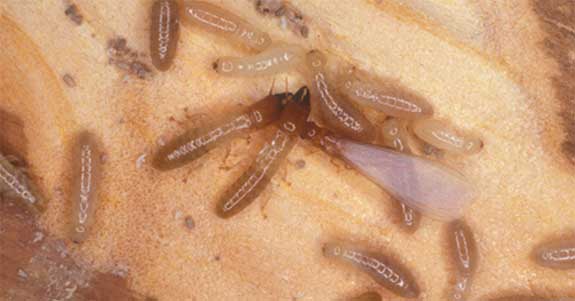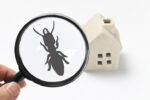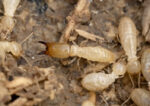
What are these Swarming Insects? Termites?
Most South Floridians would agree that our climate is hot all year long. Although South Florida may not undergo the drastic changes in weather as seen in other parts of the country, there are definitely some noticeable changes. As we shift from the dry season to the wet season, and then from spring to summer, South Florida will continue to become more hot and humid. Sure, this makes for great beach weather, but this is also the peak conditions for most flying insects; Most notably, swarming termites! But don’t worry, Hulett Environmental Services has been protecting homes in South Florida from termites since 1968.
So What Exactly are Termites?
Termites are very complex and social insects. Termites have a “caste” system, meaning the different members of the colony all have different responsibilities. The “soldiers” are for defense against ants or other intruders, the “workers” are responsible for eating the wood in your home to feed the colony and to take care of the young, and the “swarmers”, or “Queens and Kings” are meant for reproduction. Termite “swarmers” have four, equal-sized wings that allow them to fly to initiate new colonies by swarming from infested wood to find a new suitable habitat to start a new colony or nest. These new colonies will inevitably grow and can do enormous damage to your home or business.
Because of the suitable climate, there are several different types of termites here in South Florida. During a “swarm”, hundreds or thousands of flying termites can be found swarming from infested wood in order to reproduce and start a new colony. Because of this, many times the first indication of a termite infestation is the home or businesses owner discovering the swarming termites in or around their structure. Unfortunately, waking up to a termite swarm in your home is an experience many South Floridians know all too well.
Depending on the species of termite swarmer, the recommended treatment will change. This is because each group of termites have a different biology, so a different treatment method is needed. But don’t worry, you can depend on Hulett Environmental Services to complete a thorough inspection, find and correctly identify the swarming termites, determine if there is an infestation present, and recommend the proper treatment method based on the inspection. You can depend on Hulett, a local pest control company that has provided Pest, Rodent, Termite Control, and Lawn and Ornamental Spraying for over 50 years.
Swarming Insects
It is said that there are two types of homes in South Florida; those that have termites and those that will. Many of these homes become infested when a “swarm” occurs. Or, the swarmers may indicate that an infestation is already present. If that is the case, they will not go away on their own. To get rid of the termites, a termite treatment is needed. If the signs or symptoms of termites are overlooked and ignored, the damage can accumulate and become significant. If you find fecal pellets, wings, paint peeling and stains, or damage to wood, it is very important to call right away for treatment. However, sometimes damage and activity is hidden in hard to reach places, and a professional inspection is needed to find the activity. Because of this, an annual inspection is recommended.
So, what is a swarm? A swarm is when the winged members of a colony fly from the nest or galleries and try to locate a mate to start a new colony, or expand an existing colony. In South Florida, the “swarm season” is predominantly from mid-spring to autumn, depending on the termite species. The swarming termites are often attracted to light, and they fly and land on or near your home to start an infestation. Here in Florida, 20 or more different species of termites can be found swarming near and in homes, and a handful of these are known to be serious threats to wood-in-service. And if that wasn’t enough for homeowners to try and identify, there are also numerous different ants species that are commonly found swarming in and around our homes, too! For homeowners, identifying all the different types of flying insects can be difficult. However, with inspectors that are trained by an Entomologist and State Certified Operators, Hulett can help. If you find swarmers in your home but cannot determine if they are ants or termites, there are a few helpful tips and tricks. For example, ants will have elbowed-antenna and a pinched-abdomen, whereas termites will have straight-antenna and a broad-waist.
Different Types of Termites
There are at least 20 species of Termites that can be found in Florida. Of these, the termite species that are a considerable threat to structures can be grouped and classified as either Subterranean Termites or Drywood Termites, based on their biology and habitat. It is critical to distinguish between these two groups of termites, because the treatments for them, both preventative and curative, are completely different. Subterranean and Drywood termites have different requirements to live, and will be found living in different areas. Unfortunately, all of these areas can be found in your home. A professional inspection is often needed to thoroughly inspect all of the areas commonly infested by termites, for both subterranean and drywood. You can depend on Hulett for a correct identification during a free inspection, but below are some helpful guidelines.
Subterranean Termite Identification
Subterranean termites require moisture, so they live and forage in the soil. They primarily invade homes at the ground level, and they are often found near potential water sources, like where there may be a plumbing penetration in the kitchen or bath. This is especially true if there is a small leak, giving a source of water. Because these types of termites come from the ground, it is especially important to inspect baseboards, doorframes, flooring, low cabinetry and furniture, wall voids near the ground, plumbing penetrations, etc. However, in severe infestations, even subterranean termites can be found traveling up walls and voids and into attics, too, especially if there is a roof or window leak. They use the moisture from the soil and pack the insides of the infested lumber with “mud”, keeping their galleries nice and moist, just the way they like it. Some species of subterranean termites can have millions of termites in a single colony, so a thorough inspection is critical to detect an infestation quickly, before severe damage is incurred.
Although subterranean termites typically invade from the ground, they still have massive swarms of flying reproductives. Subterranean termites have massive colonies. If you have hundreds, or even thousands of swarming termites in your home or building, they are most likely subterranean termites. It is important to treat for subterranean termites as quickly as possible, as these termites have enormous colonies and a fast metabolism, therefore having the potential to cause damage to your home quickly. Do not ignore even just a small swarm. If only a few swarmers are found, you should still get a professional inspection, because early detection and treatment is key, before the infestations gets any worse. An inspector will be able to determine whether there is an infestation, or if possibly that just a few swarmers just entered in from the outside. In South Florida, because of the damage potential to homes, a curative or preventative termite program is recommended. There are many different types of subterranean termites. It will likely require a professional to get a proper identification, because most of the identification characteristics are subtle and take experience to interpret. However, below are some helpful identification tips to help identify swarming subterranean termites:
· Native subterranean termites (Reticulitermes sp.): Small, black in color (mostly), with a wrinkled-looking wing pattern.
· Asian subterranean termite (Coptotermes gestroi): Large, yellowish colored termite with a dark-Carmel colored back.
· Formosan subterranean termite (Coptotermes formosanus): Large, yellow termite with a hairy body and wings.
Treatment for Subterranean Termites
Subterranean termites are exterminated by either a soil treatment, referred to as Hulett’s Liquid Defense Treatment, or by in-ground bait stations, referred to as the Sentricon® Colony Elimination System. Hulett’s Liquid Defense Treatment creates an invisible liquid barrier around your home, killing termites that crawl through the treatment zone quickly, and protecting your home from invasion. The Sentricon® baiting system uses a bait matrix with an insect growth regulator. The active ingredient in the bait is passed throughout the entire colony, resulting in total colony elimination. If you suspect your home may be infested with subterranean termites, schedule a free inspection with Hulett, and a trained professional will discuss with you the best treatment options for your home.
Drywood Termites
Drywood termites, on the other hand, do not infest from the ground. Drywood termites infest homes primarily through reproductive swarms. Drywood termites swarm from nearby infested structures, swarm towards lights, and land on homes. Once they land, they drop their wings so they can better crawl into cracks and crevices, they find a mate, and initiate a new colony. Because of this, the common areas of new infestations in homes are doorframes, window frames, fascia, soffit areas, and the attic. However, sometimes drywood termites are also brought into a home in furniture or cabinetry. Once an infestation begins, the Queen will continue to lay eggs, and the workers will eat the interior of the lumber, creating galleries and compromising the structural integrity of the wood. The drywood termites will continue to excavate the interiors of the wood by feeding and expelling their fecal pellets out of the galleries and onto the floor through tiny holes they make in the sides of the wood, referred to as “kick-out” holes. Drywood termites live and feed within lumber, and continue to excavate the wood to make room for their growing colony. Over time, significant damage can be done. Because of this behavior, the first signs of a drywood termite infestation are often the little piles of fecal pellets, referred to as “frass”. This frass is six-sided and resembles coffee grounds. Or, after a swarm occurs, the homeowner may find several drywood termite wings, which have an iridescent and rainbow-like tint.
Drywood Termite Identification
The Drywood termite that primarily infests homes in South Florida is the West Indian Drywood Termite, Cryptotermes brevis. The swarmer of the West Indian Drywood Termite is small, Light-Carmel in color, and its wings are often dropped around the house. The wings have an iridescent-tint and have thick venation at the top of the wing. However, there are other types of drywood termites that swarm in South Florida, too. The Southeastern Drywood Termite, Incisitermes snyderi, can also be found infesting homes. This termite swarmer is larger, and a yellow-orange color.
Drywood Termite Treatment
Drywood termites are exterminated either by tent fumigation, or by Hulett’s “No-Tent” termite treatment. Drywood termites do not live in the soil, they are contained within the home. Because of this, tent fumigation is able to control all of the infesting drywood termite colonies. However, the customer preparations and evacuation required for tent fumigation can be laborious and expensive. With Hulett’s “No Tent” Termite Treatment, advanced products are applied directly into the termite galleries in the areas of activity, getting control of the infestation. Our “No-Tent” treatment also includes a preventative treatment to the commonly infested areas to help reduce the likelihood of future infestation attempts. The best part about the “No Tent” treatment is that there is no need to vacate your home while the treatment takes place, you do not have to remove or dispose of food products in your home, medications and cosmetics can remain where they are, and you do not need to prepare the exterior of your home for a tent. It’s the hassle free termite solution, and it is Guaranteed! If you suspect your home may be infested with drywood termites, schedule a free inspection with Hulett, and a trained professional will discuss with you the best treatment options for your home.
Dampwood Termites
If that was not enough for homeowners to keep straight, there is also a group of termites referred to as the Florida Dampwood termite, Neotermes. Fortunate for homeowners, Dampwood termites are usually unable to invade homes due to a lack of moisture, and unlike subterranean termites, they are unable to use the moisture from the soil. Dampwood termites are very common in trees and the forested areas surrounding homes. Because of their abundance in trees, it is common to see these very large, red-brown colored swarmers on windows, screen enclosure, doors, or sometimes even within the home. However, because of their need of moisture, they are rarely able to infest.
Termite Inspection
Yes, this is a lot of information to decipher as a homeowner. Leave it to Hulett. If you think you may have a termite infestation, or want to stop the problem before it starts, contact Hulett today. We’ll schedule a free inspection of your home and discuss with you the recommended treatment to get rid of your subterranean or drywood termites, or help prevent them in the first place. If you have found swarmers in your home, upload a photo on our website to be reviewed by our staff Entomologist. Our team will review your information and get back to you with our advice on the next steps. Contact us today to talk to an expert and schedule a free inspection of your home. Don’t let termites win the battle, take control of your home with the help of Hulett Environmental Services.



